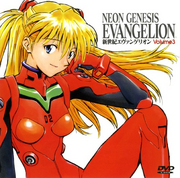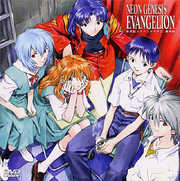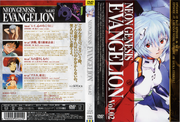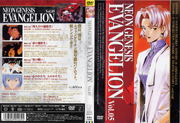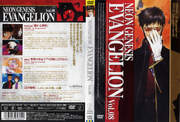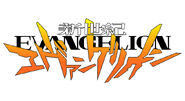- For other uses, see Evangelion (disambiguation).
This article has a collection of images to further represent its content. To see its gallery, visit Neon Genesis Evangelion (anime)/Gallery.
Neon Genesis EvangelionWP (新世紀エヴァンゲリオン, Shin Seiki Evangerion?, lit. New Century Evangelion), commonly referred to simply as Evangelion, is a Japanese anime TV series created by GAINAX that began in 04 October 1995 and ended on 19 July 1997. The anime was written and directed by Hideaki Anno, and co-produced by TV Tokyo and Nihon Ad Systems (NAS). It gained international renown and won several animation awards, and was the start of the Neon Genesis Evangelion series.
The name Shin Seiki Evangerion translates directly as "New Century Evangelion" or "New Era Evangelion". The term "Evangelion" is related to the ancient Greek term for "good messenger" or "good news". The name was chosen in part for its religious symbolism, as well as for the fact that Hideaki Anno said that he liked the word "Evangelion" because it "sound[ed] complicated". [citation needed]
The Evangelion series revolves around the organization NERV, using large mechas called Evangelions to combat monstrous beings called Angels. They are piloted by several of the main characters, including Shinji Ikari, Asuka Sohryu, and Rei Ayanami. While the initial episodes focus largely on religious symbols and specific references to the Bible, the later episodes tend to go deeper into the psyches of the characters, where it is learned that many of them have deep-seated mental and emotional issues. Through the exploration of these issues, the show begins to question reality and the existences therein. Much of the series' content was based on Hideaki Anno's own clinical depression.[1]
Episodes[]
Each episode has both a Japanese title (shown at the beginning of each episode) and an English title (displayed in the mid-episode eyecatches). Like the title Neon Genesis Evangelion, the English episode titles were created by GAINAX.
- Main article: Episode:Index
Setting[]
The story of Neon Genesis Evangelion primarily begins in 2000 with the "Second Impact", a global cataclysm which almost completely destroyed Antarctica and led to the deaths of half the human population of Earth. The Impact is believed by the public at large and even most of NERV to have been the impact of a meteorite landing in Antarctica, causing devastating tsunamis and a change in the Earth's axial tilt (leading to global climate change) and subsequent geopolitical unrest, nuclear war (such as the nuking of Tokyo), and general economic distress. Later, Second Impact is revealed to be the result of contact with and experimentation on the first of what are collectively dubbed the Angels: Adam. The experiments were sponsored by the mysterious organization SEELE, and carried out by the research organization Gehirn.
In the year 2010, Gehirn had accomplished a number of its scientific and engineering goals and corporately changed into the paramilitary organization NERV which is headquartered in Tokyo-3, a militarized civilian city located on one of the last dry sections of Japan; NERV's central mission is to locate the remaining Angels predicted by SEELE, and to destroy them. However, NERV has its own secret agenda, as directed by its Machiavellian commander Gendo Ikari: the Human Instrumentality Project, which, according to Gendo in episode 25, is the task of uniting all human minds into one global spiritual entity. Associated with NERV is the Marduk Institute, which has the task of selecting the pilots for the Evas, the most capable being children conceived after the Second Impact (14-year-olds). The institute consists of Commander Ikari, and NERV's chief scientist Ritsuko Akagi; supporting the two are 108 companies which are all revealed to be ghost companies.
Story[]
As the first episode opens in the year 2015, Tokyo-3 is being attacked by the third Angel. Conventional weapons prove ineffective, largely due to its projected force field called an AT Field. NERV takes command of the battles, and is able to intercept and defeat the Angels using the Evangelions, biomechanical mecha previously developed in secret by Gehirn inside the underground GeoFront; the Geofront is located underneath Tokyo-3.
Not knowing why his father summoned him, Shinji Ikari, a 14-year-old boy arrives in Tokyo-3 just as the Third Angel attacks the city. Shinji reluctantly agrees to join NERV to pilot Evangelion Unit-01, and begins living with Captain Misato Katsuragi. He and Rei Ayanami battle the successive advances of the Angels together and are later joined by Asuka Langley Soryu, the pilot of Unit-02.
Each EVA has its own designated pilot (Unit-00 – Rei, Unit-01 – Shinji, Unit-02 – Asuka, and subsequently Unit-03 – Toji Suzuhara), and operates by synchronizing the pilot's soul and the human soul inside the EVA via the enigmatic liquid substance known as LCL. Surrounded by LCL, the pilot's nervous system, mind, and body join with the EVA's controls, allowing the EVA to be controlled by the pilot's thoughts and actions. The higher a pilot's synchronization ratio, the better the pilot can control the EVA and fight more adeptly.
While Ritsuko mentions at the series' beginning that the EVAS do have some biological components to them, the extent of this is not immediately apparent. Unit-01 is connected to Yui Ikari, Gendo's wife, and Shinji's mother, since it absorbed her body and soul in a failed experiment, as shown in episodes 16 and 20. Rei herself is suspected to be a partial clone of Yui, and is known to harbor the soul of Lilith, the Second Angel.[2]
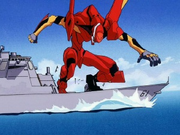
The EVA Unit-02 landing on the missile destroyer USS RamageWP
It is finally revealed, towards the end of the series, that the EVAS are not really "robots" but are actually cloned Angels (Units 00, 02, 03, and 04 are made from Adam, and 01 is made from Lilith) onto which mechanical components are incorporated as a means of restraint and control. This control is not perfect, as various units are shown over the course of the series driving into "berserker" mode, in which they can act of their own will, independent of any artificial power input.
Along with the battles against the Angels, the central characters struggle to overcome their personal issues and personality conflicts, which factor heavily into the events of the series and its eventual conclusion. Throughout the series, many of the main characters constantly have to cope with several social and emotional problems: characters are unwillingly forced to confront socially complex and challenging situations; unresolved sexual tensions grow between numerous characters; injuries, deaths, and defeats cause blows to their psyches; and previously steady relationships begin to falter.
Over the final months of 2015, the characters begin to learn of the true plan of NERV and SEELE, the Human Instrumentality Project. Its purpose is to force the completion of human evolution, and thereby save it from destroying itself. To do so, they plan to break down the AT fields that separate individual humans, and in doing so, reducing all humans to LCL, which is revealed to be the "primordial soup", the fundamental composite of human beings. All LCL would then be united into a supreme being, the next stage of humanity, ending all conflict, loneliness and pain brought about by individual existence. At the end of the series, SEELE and NERV come into direct conflict over the implementation of Instrumentality.
In the last two episodes (the second set in 2016), Gendo and Rei initiate the Human Instrumentality Project, forcing several characters (especially Shinji[3]) to face their doubts and fears and examine their self-worth, with sequences that "suggest animated schizophrenia".[4] This ending was made up of flashbacks, sketchy artwork, and flashing text "over a montage of bleak visuals, that include black and white photos of desolate urban motifs such as a riderless bicycle or vacant park benches interspersed with graphic stills of the devastated NERV headquarters in which Shinji's colleagues are seen as bloodstained bodies",[5] and a brief interlude depicting an "alternate" Evangelion universe with the same characters but apparently in the high school comedy genre, eventually seems to depict Shinji concluding that life could be worth living and that he did not need to pilot an Eva to justify his existence; he is then surrounded by most of the cast, clapping and congratulating him. The introduction implies that this same process took place for everyone.
Characters[]
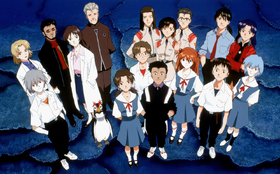
King Records' Laserdisc & VT volume 14, illustrated by Takeshi Honda
- Main article: Characters
| “ | It's strange that 'Evangelion' has become such a hit—all the characters are so sick! | ” |
| —Hideaki Anno (1996) |
| Character Name | Kana | Role | Episodes |
|---|---|---|---|
| Shinji Ikari | 碇 シンジ | Protagonist | 28 |
| Asuka Sohryu | 惣流 アスカ | Protagonist | 20 |
| Misato Katsuragi | 葛城 ミサト | Protagonist | 27 |
| Gendo Ikari | 碇 ゲンドウ | Protagonist, Antagonist | 28 |
| Rei Ayanami | 綾波 レイ | Protagonist | 27 |
| Ritsuko Akagi | 赤木 リツコ | Supporting character | 27 |
| Tōji Suzuhara | 鈴原 トウジ | Supporting character | 13 |
| Kensuke Aida | 相田 ケンスケ | Minor character | 14 |
| Kaworu Nagisa | 渚 カヲル | Supporting character | 2 |
| Kōzō Fuyutsuki | 冬月 コウゾウ | Minor character | 28 |
| Keel Lorenz | キ��ル ローレンツ | Antagonist | ?? |
| Hikari Horaki | 洞木 ヒカリ | Minor character | ?? |
| Pen Pen | ペン² | Minor character | ?? |
Origin and production[]
Honnêamise sequel[]
In March 1992, GAINAX had begun planning and production of an anime movie called Aoki Uru, which was to be a sequel to Oritsu Uchugun set 50 years later (so as to be easier to pitch to investors[6]) which, like Oritsu, would follow a group of fighter pilots. Production would eventually cease in July 1993: a full-length anime film was just beyond GAINAX's financial ability – many of its core businesses were shutting down or producing minimal amounts of money:
| “ | "General Products had closed shop. We'd pulled out of Wonder Festival [a "flea market for garage kits"] and garage kit making altogether. We weren't taking on any subcontracting work for anime production. We did continue to make PC games – Akai had seen to that – but there wasn't a lot of work tossed our way. With mere pennies coming in, we were having a hard enough time just paying everyone's salaries. Finally the order came down for us to halt production on Aoki Uru. We were simply incapable of taking the project any further." | ” |
| — |
Anno's personal biography describes this period:
| “ | "In 1991, Anno spent many unproductive days as a result of his inability to mentally distance himself from the Nadia series even after the broadcast had ended. He would work out numerous plans and projects, both on his own initiative and in collaboration with others, but they all fell through, and in the end, Anno's idle days were dotted with projects that he imploded by design. In the midst of all this, one project, a feature film entitled Blue Uru, finally took shape and animation production began, only to be shut down due to circumstances beyond his control." | ” |
| —Anno's personal biography at khara website |
Evangelion pre-release[]
With the failure of the project, Anno, who had been slated from the beginning to direct Aoki Uru, was freed up. Legendarily, he would soon agree to a collaboration between King Records and GAINAX while drinking with Toshimichi Ōtsuki, a representative at King Records;[9] with King Records guaranteeing a time slot for "something, anything",[8] Anno set about actually making the anime. Unsurprisingly, elements of Aoki Uru were incorporated into the nascent Evangelion:
"One of the key themes in Aoki Uru had been "not running away." In the story, the main character is faced with the daunting task of saving the heroine … He ran away from something in the past, so he decides that this time he will stand his ground. The same theme was carried over into Evangelion, but I think it was something more than just transposing one show's theme onto another …"[10]
The original early plotline for Evangelion remained relatively stable through development, although later episodes appear to have changed dramatically from the fluid and uncertain early conceptions; for example, originally there were 28 Angels and not 17, and the climax would deal with the defeat of the final 12 Angels and not with the operation of the Human Instrumentality Project. As well, Kaworu Nagisa's initial design was a schoolboy who could switch to an "Angel form", accompanied by a pet cat.[11]
Production was by no means placid. Sadamoto's authorship of the manga (Neon Genesis Evangelion) caused problems as multiple publishers felt "that he was too passé to be bankable";[12] the stylized mecha design that Evangelion would later be praised for was initially deprecated by some of the possible sponsors of a mecha anime (toy companies) as being too difficult to manufacture (possibly on purpose),[13] and that models of the Evangelions "would never sell."[14] Eventually, Sega agreed to license all toy and video game sales.
Airing[]
After several episodes were produced, Evangelion began to be shown: the first episode aired on 04 October 1995, long after originally planned. Initially ignored (although received positively by those GAINAX fans invited to early screenings), viewership grew slowly and largely by word of mouth.
Episode 16 marked a distinct shift that would characterize the second half of Evangelion as being more psychological than action or adventure.[15] This change in emphasis was partly due to the development of the story, but also partly because by this point, production had begun running out of funding and failing to meet the schedule; this collapse has been identified by at least one GAINAX employee as the impetus for Evangelion's turn into metafiction:
| “ | I didn't mind it. The schedule was an utter disaster and the number of cels plummeted, so there were some places where unfortunately the quality suffered. However, the tension of the staff as we all became more desperate and frenzied certainly showed up in the film … About the time that the production system was completely falling apart, there were some opinions to the effect that, "If we can't do satisfactory work, then what's the point of continuing?" However, I didn't feel that way. My opinion was, "Why don't we show them the entire process including our breakdown." | ” |
| —A STORY OF COMMUNICATION: The Kazuya Tsurumaki Interview |
(In general, the animation[17] and dub,[18] as well as the character design, have often been praised.[19][20][21][22])
But nevertheless, by Episode 18, it had become enough of a sensation that Unit-01's violent rampage "is criticized as being unsuitable on an anime show that is viewed by children", and Episode 20 would be similarly criticized for the offscreen depiction of Misato and Ryoji having sex.[23] With this popularity came the first merchandise, "Genesis 0:1" (containing the first two episodes). Beginning a trend, it sold out. As the series concluded on 27 March 1996 with "Take care of yourself.", the story apparently remained unresolved: Third Impact and the Human Instrumentality Project are implied to have begun or even finished, but the episodes focus largely on the psychology of the characters, leaving deeply unclear what actually happens.
The radically different and experimental style of the final two episodes confused[24] or alienated many fans[25] and spawned debate and analysis, both scholarly and informal, and accusations of meaninglessness;[26] even mainstream publications like the Mainichi Times would remark that "When Episode 25 first aired the following week, nearly all viewers felt betrayed...when commentator Eiji Ōtsuka sent a letter to the Yomiuri Shimbun, complaining about the end of the Evangelion series, the debate went nationwide."[27] (It is worth noting that the ending received such coverage in part because Evangelion had attracted viewers not typically interested in such fare; the TV series was extremely popular.[28][29]) After the end of the series, Anno 'broke down'[8] and delayed the upcoming films.
The series enjoyed incredible popularity among its fan base. In 1995, the series won first place in the reader-polled "Best Loved Series" category of the Anime Grand Prix, a reader-polled award series published in AnimageWP magazine. The series was once again awarded this prize in 1996, receiving 2,853 votes, compared to the second-place show (which was unmentioned) with only 903 votes. The End of Evangelion would win first place in 1997, allowing Neon Genesis Evangelion to be the first anime franchise to win three consecutive first-place awards. This feat would not be duplicated again for several years, until Code GeassWP won the 2006, 2007, and 2008 awards. "Zankoku na Tenshi no These" won the Song category in 1995 and 1996; "The Beginning and the End, or "Knockin' on Heaven's Door"" won the 1996 Episode category; and Rei Ayanami won in the Female Character category in 1995 and 1996 (followed by Shinji Ikari winning in the Male Character category in 1996 and 1997), contributing to Megumi Hayashibara's 1995-1997 wins in the Seiyuu category (and until 2001 for other series). In 1998, EX.org's readers voted it the #1 U.S. release[30] and in 1999, the #2 series of all time.[31]
In response to the backlash by fans against the nature of the series finale, Anno made several controversial comments in the months following the series' conclusion, and preceding the release of The End of Evangelion. Anno commented in various interviews after the conclusion of the series that "anime fans need to have more self-respect" and to "come back to reality"; in a Newtype interview on 10 May, after the announcement on 26 April of a new movie and re-edited versions of the TV series, he also stated that "computer networking is graffiti on toilet walls."[23] These statements were even more controversial.
Episode List Staff[]
| Episode | Screenplay | Storyboard | Director | Animation Director |
Airing Date |
|---|---|---|---|---|---|
| Opening | - | Hideaki Anno |
Kazuya Tsurumaki | - | - |
| Episode:01 | Hideaki Anno | Hideaki Anno Masayuki |
Kazuya Tsurumaki | Shunji Suzuki | 04 October 1995 |
| Episode:02 | Hideaki Anno Yōji Enokido |
Hideaki Anno Masayuki |
Kazuya Tsurumaki | Takeshi Honda | 11 October 1995 |
| Episode:03 | Hideaki Anno Akio Satsukawa |
Kazuya Tsurumaki Hiroyuki Ishidō |
Hiroyuki Ishidō | Nobuhiro Hosoi | 18 October 1995 |
| Episode:04 | Akio Satsukawa | Jun'ichi Satō | Tsuyoshi Kaga | Satoshi Shigeta | 25 October 1995 |
| Episode:05 | Hideaki Anno Akio Satsukawa |
Jun'ichi Satō | Keiichi Sugiyama | Shunji Suzuki | 01 November 1995 |
| Episode:06 | Hideaki Anno Akio Satsukawa |
Masayuki | Hiroyuki Ishidō | Nobuhiro Hosoi | 08 November 1995 |
| Episode:07 | Hideaki Anno Yōji Enokido |
Keiichi Sugiyama Hideaki Anno |
Keiichi Sugiyama | Shunji Suzuki | 15 November 1995 |
| Episode:08 | Hideaki Anno Yōji Enokido |
Shinji Higuchi | Kazuya Tsurumaki | Takeshi Honda | 22 November 1995 |
| Episode:09 | Hideaki Anno Akio Satsukawa |
Shinji Higuchi | Seiji Mizushima | Shinya Hasegawa | 29 November 1995 |
| Episode:10 | Hideaki Anno Akio Satsukawa |
Tsuyoshi Kaga Hideaki Anno |
Tsuyoshi Kaga Hiroyuki Ishidō |
Satoshi Shigeta | 06 December 1995 |
| Episode:11 | Hideaki Anno Yōji Enokido |
Masayuki | Tetsuya Watanabe | Toshio Kawaguchi | 13 December 1995 |
| Episode:12 | Hideaki Anno Akio Satsukawa |
Masayuki | Hiroyuki Ishidō | Satoshi Shigeta | 20 December 1995 |
| Episode:13 | Hideaki Anno Mitsuo Iso |
Tensai Okamura | Tensai Okamura | Kazuchika Kise | 27 December 1995 |
| Episode:14 | Hideaki Anno | Hideaki Anno | Masahiko Ōtsuka Ken Andō |
Kazuya Tsurumaki | 03 January 1996 |
| Episode:15 | Hideaki Anno Akio Satsukawa |
Jun'ichi Satō | Naoyasu Habu | Shunji Suzuki | 10 January 1996 |
| Episode:16 | Hideaki Anno Hiroshi Yamaguchi |
Kazuya Tsurumaki | Kazuya Tsurumaki | Shinya Hasegawae | 17 January 1996 |
| Episode:17 | Hideaki Anno Shinji Higuchi |
Akira Oguro | Minoru Ōhara | Tomonori Kogawa | 24 January 1996 |
| Episode:18 | Hideaki Anno Shinji Higuchi |
Tensai Okamura | Tensai Okamura | Kazuchika Kise | 31 January 1996 |
| Episode:19 | Hideaki Anno Akio Satsukawa |
Masayuki | Masayuki | Takeshi Honda | 07 February 1996 |
| Episode:20 | Hideaki Anno | Kazuya Tsurumaki Hideaki Anno |
Masahiko Ōtsuka | Kazuya Tsurumaki | 14 February 1996 |
| Episode:21 | Hideaki Anno Akio Satsukawa |
Jun'ichi Satō | Hiroyuki Ishidō (TV) Masahiko Ōtsuka Shunji Suzuki (DC) |
Satoshi Shigeta | 21 February 1996 |
| Episode:22 | Hideaki Anno Hiroshi Yamaguchi |
Kazuya Tsurumaki | Akira Takamura (TV) Kazuya Tsurumaki (DC) |
Kazuya Tsurumaki Yoshiyuki Sadamoto Tomonori Kogawa |
28 February 1996 |
| Episode:23 | Hideaki Anno Hiroshi Yamaguchi |
Kazuya Tsurumaki Hideaki Anno |
Shōichi Masuo | Shunji Suzuki | 06 March 1996 |
| Episode:24 | Hideaki Anno Akio Satsukawa |
Masayuki | Masayuki | Masayuki | 13 March 1996 |
| Episode:25 | Hideaki Anno | Kazuya Tsurumaki Hideaki Anno |
Kazuya Tsurumaki | - | 20 March 1996 |
| Episode:26 | Hideaki Anno | Masayuki Kazuya Tsurumaki Hideaki Anno |
Masayuki Kazuya Tsurumaki |
- | 27 March 1996 |
Video Releases[]
The series and its films has had many home video releases, like VHS, LaserDisc, DVD, Blu-ray and streaming.
VHS Release[]
Neon Genesis Evangelion was released on a series of 17 tapes from 03 February 1996 to 23 December 1998. Each tape generally contained two episodes of the show, with The End of Evangelion split between two releases and edited to resemble episodes. Each tape was named Genesis 0:1 - 0:14, with the last tape, 0:X containing the TV versions of episodes 21-24. 0:X was only available through mail order with proof of purchase for every Genesis volume. The theatrical version of The End of Evangelion was released as part of a two-tape box set alongside Death and Rebirth. Also included in each Genesis release was an "Eva Fan Club" sheet.
| Title | Release date | Catalog number | Episodes | Cover |
|---|---|---|---|---|
| Genesis 0:1 | 03 February 1996 |
KIVA-249 | 1-2 | 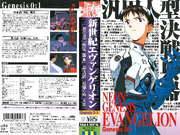 |
| Genesis 0:2 | 06 March 1996 |
KIVA-250 | 3-4 |  |
| Genesis 0:3 | 05 April 1996 |
KIVA-251 | 5-6 | 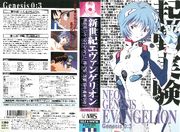 |
| Genesis 0:4 | 02 May 1996 |
KIVA-252 | 7-8 |  |
| Genesis 0:5 | 05 June 1996 |
KIVA-253 | 9-10 |  |
| Genesis 0:6 | 05 July 1996 |
KIVA-254 | 11-12 | 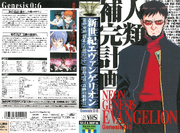 |
| Genesis 0:7 | 07 August 1996 |
KIVA-255 | 13-14 |  |
| Genesis 0:8 | 05 September 1996 |
KIVA-256 | 15-16 |  |
| Genesis 0:9 | 02 October 1996 |
KIVA-257 | 17-18 |  |
| Genesis 0:10 | 05 December 1996 |
KIVA-258 | 19-20 | 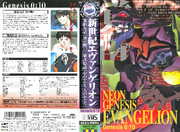 |
| Genesis 0:11 | 04 February 1998 |
KIVA-259 | 21'-22' |  |
| Genesis 0:12 | 03 July 1998 |
KIVA-260 | 23'-24' |  |
| Genesis 0:13 | 12 August 1998 |
KIVA-261 | 25-25' |  |
| Genesis 0:14 | 09 September 1998 |
KIVA-311 | 26-26' |  |
| Genesis 0:X | Early 1999 |
SVG7 | 21-24 |  |
| Theatrical Box Set | 23 December 1998 |
KIVA-9401~2 / KFOVA-157 | TEoE, D&R |
LaserDisc Release[]
The LaserDisc release was mostly identical to the VHS Genesis series. Each disc was CAV format with analog and digital stereo audio. The first pressing for volumes 1, 6, and 10 included boxes to hold the separate releases. The CLV format was used for Genesis 0:X and the episodic form of The End of Evangelion
| Title | Release date | Catalog number | Episodes | Cover |
|---|---|---|---|---|
| Genesis 0:1 | 03 February 1996 |
KILA-149 | 1-2 |  |
| Genesis 0:2 | 06 March 1996 |
KILA-150 | 3-4 |  |
| Genesis 0:3 | 05 April 1996 |
KILA-151 | 5-6 | 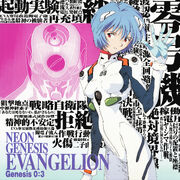 |
| Genesis 0:4 | 02 May 1996 |
KILA-152 | 7-8 |  |
| Genesis 0:5 | 05 June 1996 |
KILA-153 | 9-10 |  |
| Genesis 0:6 | 05 July 1996 |
KILA-154 | 11-12 |  |
| Genesis 0:7 | 07 August 1996 |
KILA-155 | 13-14 |  |
| Genesis 0:8 | 05 September 1996 |
KILA-156 | 15-16 |  |
| Genesis 0:9 | 02 October 1996 |
KILA-157 | 17-18 |  |
| Genesis 0:10 | 05 December 1996 |
KILA-158 | 19-20 |  |
| Genesis 0:11 | 04 February 1998 |
KILA-159 | 21'-22' |  |
| Genesis 0:12 | 03 July 1998 |
KILA-160 | 23'-24' |  |
| Genesis 0:13 | 12 August 1998 |
KILA-161 | 25-25' |  |
| Genesis 0:14 | 09 September 1998 |
KILA-311 | 26-26' |  |
| Genesis 0:X | Early 1999 |
3SLG2 | 21-24 |  |
| Theatrical Box Set | 23 December 1998 |
KILA-9401~4 / KFOLA-157 | TEoE, D&R |
1990s DVD release[]
Neon Genesis Evangelion was first released on DVD between 19 July 1997 and 22 September 1999. Each volume contained four episodes, with a total of eight releases. Volume 7 contained episodes 25-26 as well as the episodic version of The End of Evangelion. The theatrical edition of The End of Evangelion was released as a separate DVD alongside Death and Rebirth. Each DVD is 4:3 interlaced video, except for the films, which are 16:9 progressive scan. The Theatrical Edition release is the only DVD to contain the real version of REBIRTH.
Second Impact Box[]
The original DVD releases were collected in three box sets, each containing three DVDs. The third box also included the Neon Genesis Evangelion: Iron Maiden PC game, but removed the episodic version of The End of Evangelion from Volume 7. The cover art of each volume was changed for this release.[34]
2003 Renewal DVD release[]
A new set of DVDs was later released as part of a Renewal of Evangelion campaign, which included a complete remastering of the audio and video from the original 16mm prints. The series was released on 10 DVDs, with each single containing four episodes. Volume 8 contains only episodes 25 and 26, but fills the remaining space with a 5.1 DVD audio version of 22 songs from the series. The films DEATH(TRUE)² and The End of Evangelion were released as a two-disc pack named The Feature Films: Neon Genesis Evangelion. This release was also remastered with DTS audio and sold as a separate DTS Collector's Edition.
DVD-BOX[]
The NEON GENESIS EVANGELION DVD-BOX (Remastered DVD) Renewal singles were collected as an 11-disc box set and released on 25 June 2003. The set contained each episode of the series, as well as both films and the on-air cuts of 21-24. Also included was a bonus disc with the Genesis 0:0 and 0:0 PVs and other trailers for the series. The bonus disc also included the cut live action sequence from The End of Evangelion. The 14 "Eva Fan Club" sheets from the Genesis releases were reprinted and included with this set. The box was reprinted on 23 April 2007, shortly before the 2007 edition of the box set was released.
DVD-BOX '07 Edition[]
A re-release of the 2003 Box Set's material in a slimmer case. This version did not include the Eva Fan Club sheets. The set was released on 01 August 2007.
NTV Box Set[]
A special order box set from Nihon Terebi containing the eight single Renewal volumes, the Test-Type DVD, and The Feature Films. The cases came in a slipcover with three separate holders, marked "Evangelion 00" through "Evangelion 02".
Blu-ray BOX[]
The Blu-ray BOX was released on 26 August 2015.
Re-releases[]
Following the series' end, Hideaki Anno was dissatisfied as a result of time constraints, budgetary problems, and network censorship issues. When the series was finally released as a VHS set, the series was remastered and additional footage was provided in Episodes 21 through 24, and Episodes 25 and 26 were completely remade into Death and Rebirth. However, the original remastering was put somewhat aside to favor the film, again in part due to budget constraints. Following this, Anno decided that Rebirth II should include some of the previous animations, and ended up being renamed The End of Evangelion. In 1998, the Evangelion films were released in their original intended form, without the extra scenes in the recap film (DEATH(TRUE)²) and with the full new ending.
In 2000, the "Second Impact Box" was released in three parts, containing Episode 26 uncut, as well as the remastered episodes and the two films (also including REBIRTH).
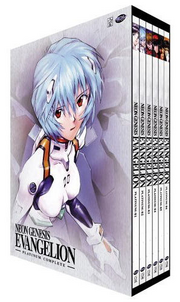
Platinum Complete DVD Box
In 2003, the nine-volume Renewal of Evangelion DVDs were released, with the series' sound and picture remastered for HD and 5.1 technology. The first eight volumes covered the original 26 episodes (with two versions of episodes 21-24: the uncut version and a reconstruction of the edited version). The ninth volume, containing two discs, named Evangelion: The Movie, contained DEATH(TRUE)² and End of Evangelion. The Renewal release formed the basis for the Western Platinum Edition, which features slightly different English subtitles than the original VHS and DVD releases. The original dub of Episodes 25 and 26 were replaced with only the "Director's Cut" dubs of these episodes.
Inspiration[]
Evangelion is filled with allusions to biological, military, religious, and psychological concepts, as well as numerous references or homages to older anime series (for example, the basic plot is seen in earlier anime like Space Battleship YamatoWP), a tendency which inspired the nickname for the series, the "remixed anime". Hideaki Anno's use of Freudian psychoanalytical theory, as well as his allusions to religion and biology are often idiosyncratically used and redefined to carry his message. This tendency of Anno's has been criticized as "total plagiarism" and "just more mindgames from the animation crew". However, Anno has defended himself by denying the possibility of really original work without borrowing in anime.
| “ | The people who make anime and the people who watch it always want the same things. The creators have been making the same story for about 10 years; the viewers seem to be satisfied and there's no sense of urgency. There's no future in that. | ” |
| —Hideaki Anno, Wong 1996 |
Anno's original goal, which was arguably achieved, was to reinvigorate the anime genre and create a "new" anime. He has imbued many symbols and interesting perspectives into the series and individual episodes. A number of these symbols were noted on the English DVD commentary for Death and Rebirth and End of Evangelion.
Many of the characters share their names with Japanese warships from World War II (such as the SōryūWP, AkagiWP, and KatsuragiWP; though the ship names and character names are written with different kanji, they share the same pronunciations). Other characters' names refer to other works of fiction, such as the two characters named after the protagonists of Ryu MurakamiWP's 1987 novel Fascism in Love and Fantasy (Ai to Genso no Fascism, 愛と幻想のファシズム?): the two main characters are named Aida Kensuke and Suzuhara Toji; Anno later directed a film adaptation of Murakami's novel, Love & PopWP).
Psychoanalysis[]
Evangelion is often considered a deeply personal expression of Hideaki Anno's personal struggles.[1] From the start, Evangelion invokes many psychological themes. Oftentimes, titles of episodes, titles of music used in the series, and other repeated phrases are based on psychological concepts such as those of Sigmund FreudWP and Jacques LacanWP. Some such phrases include "Thanatos", "oral stage", "separation anxiety", and "mother is the first other" (based on Freud's idea of the Oedipus complexWP).
The episodes also seem laden with some deeper psychological concepts. Some have speculated on the significance of the descent into the GeoFront in Tokyo-3 as being related to a "dive into the unconscious". Additionally, the EVAS' connection with their pilots could be deciphered as a psychological connection and conflict. As the series progresses, the hedgehog's dilemmaWP is mentioned, referring to humans' inability to get close to each other without causing pain to one another; this term is used to related directly to Shinji Ikari, but applies to other characters in the series as well.
Beyond Freud and Lacan, elements of Gestalt therapyWP are laden throughout the series. This theory is directly referenced in Episode 15, when the concepts of homeostasis and transistasis are mentioned. Furthermore, Episode 19 is titled "Introjection", a Gestalt term for a mechanism in the human brain designed to process experiences.
The characters in the series seem to extend deep psychological traumas, oftentimes in relationship with their parents. Shinji, a classic case of introversion and social anxiety, seems to get his psychological traits from the loss of his mother at such an early age, coupled with the perception of his father abandoning him. Asuka, a victim of her mother's insanity, found her mother after she committed suicide, which led to her hardened exterior personality and satisfaction from piloting the EVAS. Like Shinji, Misato experienced neglect from her father; in Episode 25, Misato mentions that Ryoji Kaji reminds her of her father, which has led to an ambivalent feeling toward him. A display of further conflict is seen from Ritsuko, who, after seeing her mother having an affair with Gendo, is simultaneously attracted and spiteful toward him.
To further the psychological prevalence in the final two episodes, they are stripped of their colorful visuals and shot with muted tones as Shinji is heard asking himself deep, brooding psychological questions. In these two episodes, Shinji and Asuka both display the fact that they experienced similar pasts; Shinji, however, claims he has no life without the EVAS, though this is later disproved in the final scene of Episode 26.
Religion[]
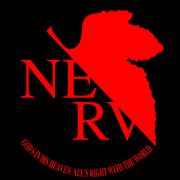
NERV's logo featuring half a fig leaf
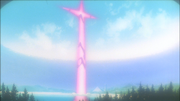
The destruction of an Angel causes an cross-shaped explosion, representing a Christian icon.
The themes in Evangelion are often drawn from religious symbols, such as those from Judaism, Christianity, Gnosticism, and Kabbalism. Hidaeki Anno has said that, in this work of science fiction, one of the main goals of GAINAX was to examine the nature of philosophy and religion, and to bring forth questions about god.[36]
Kazuya Tsurumaki, a recurring assistant director, has stated that they chose to use religious symbolism simply to set themselves apart from other shows featuring giant mechas, and that it didn't have any prominent meaning beyond this.[37] Gainax's PR department head, Hiroki Sato and former president Toshio Okada have made similar statements.[38]
There are several individual religious references seen throughout the series.
- The Christian cross is shown often, many times as the result of large explosions (particularly those of the Angels).
- The Angels themselves are a reference to the angelsWP of God, particularly from the Old Testament.
- The names of the Magi supercomputers, as well as the "Magi" itself, are references to the Biblical MagiWP.
- The Tree of Life of Kabbalism is mentioned.
- The Marduk Institute is the name of the chief deity from the Babylonian mythos.
Human Instrumentality Project[]
- Main article: Human Instrumentality Project
The Human Instrumentality Project shows a strong influence from Arthur C. ClarkeWP's novel Childhood's EndWP, an influence Anno acknowledged. Similarities between the works, such as the larger themes and the declining birth rate after the Second Impact, were gleaned from this work.
Legacy[]
Anime[]
From the period from 1984 to the release of Evangelion, most highly acclaimed anime had a style somehow distanced from the usual styles of anime. For example, Hayao MiyazakiWP's My Neighbor TotoroWP (1988), and Kiki's Delivery ServiceWP (1989) were both low-key works, while Katsuhiro OtomoWP AkiraWP (1988) was influenced by American comic books. Acclaimed director Mamoru OshiiWP had said that, in the words of Hiroki AzumaWP, nobody wanted to watch "simple anime-like works" anymore. Evangelion, however, shows the reversal of this trend. It fully embraced the style of mecha anime, and in particular shows a large influence from Yoshiyuki TominoWP's Space Runaway IdeonWP,[39] which Anno recommends;[40] particularly, there are scenes in The End of Evangelion which are clear homages to the second film for the Space Runaway Ideon series.
As much as Evangelion has been impacted by other works like DevilmanWP,[41] the series itself has become a staple in Japanese fiction. The nature of the show made it a landmark work in the more psychological and sophisticated vein of anime that would be picked up by later works such as Revolutionary Girl UtenaWP (1997) that, like Evangelion, center on an ambiguous world-changing event to come. Serial Experiments LainWP is a later anime which dealt with many of the same themes as Evangelion,[42] and so is often thought to be influenced by Neon Genesis Evangelion, although the writer did not see any of Evangelion until he had finished the fourth episode of Lain,[43] and attributes the utility pole visual motif to independent invention and the screen captions to his borrowing from Jean-Luc GodardWP and Anno from Kon IchikawaWP. The series His and Her CircumstancesWP (1999), which was also directed by Hideaki Anno, shares techniques (the experimental 'ripping-apart' of the animation and use of real photographs) and portrayed psychological conflicts in much the same way (although the various cinematic devices can be traced back to works other than EVA, for instance, the works of Osamu TezukaWP.[44]).
Evangelion dramatically changed the design of giant robots in animated works.[citation needed] Previously, mecha or giant robot series took their "mechanical suit" designs from Mobile Suit GundamWP, MazingerWP, and other similar shows from the 1970s and 1980s. Evangelion changed this with its fast and sleek EVAS, making a noticeable contrast to the comparatively bulky and cumbersome looking PatlaborWP and Mobile Suits of the past. Indeed, the style set and created by Evangelion has become more common since its release, yet series like The King of Braves GaoGaiGarWP have continued to use the classic "mecha" style. RahXephonWP, a show with designs inspired by 1970s mecha shows, was compared to Evangelion by many English language reviewers.[45][46] Evangelion is generally viewed to be a part of the soft science fiction genre, by avoiding the technical hard S.F. approach of Gundam and other popular mecha anime in favor of psychological struggle[47] and metaphysical symbolism.[48] Some anime have been made in direct opposition to NGE; Yoshiyuki Tomino publicly stated that with Brain PowerdWP he intended to "outdo Evangelion".[49][50][51] Series or works involving similar mixtures of religion and mecha are often compared to Neon Genesis Evangelion, such as XenogearsWP[52] or GasarakiWP.[53][54]
Music[]
The UK band Fightstar's debut album, Grand Unification, is purported to have been heavily influenced by Neon Genesis Evangelion.[55] The track "Lost Like Tears in Rain" even contains the lyric "It's Neon Genesis".[56] The artwork for the record portrays vast ruined cityscapes that are reminiscent of similar scenes in Evangelion. Fightstar's second album features a track called "Unfamiliar Ceilings", a reference to the Evangelion chapter "Unfamiliar Ceiling"; there is also a song named "H.I.P. (Enough)" in which H.I.P. stands for "Human Instrumentality Project". Also, the words "Human Instrumentality Project" can be seen in the album insert booklet. Fightstar's EP Deathcar also features two Evangelion-related songs. One is titled "NERV/SEELE" and the other is titled "Shinji Ikari". The back of the EP artwork also shows an image of the Spear of Longinus visibly separating the two songs from the other tracks. Their third album, Be Human, also takes its name from an episode of Evangelion (episode 22).
See also[]
Gallery[]
Further reading[]
- (Japanese) Endo, Toru. "Konna kitanai kirei na hi ni wa" ("On a day so beautiful and so ugly"). Poppu karuchaa kuritiiku (Pop Culture Critique), volume 0. 1997.
- (Japanese) GAINAX, NEW-TYPE. E-Mono: Neon Genesis Evangelion: All Goods Catalog. ISBN4-04-852868-8
- (Japanese) Kotani, Mari. Seibo Evangelion (Evangelion as the Immaculate Virgin). Tokyo: Magajin Hausu. 1997.
- (Japanese) Kotani, Mari. A New Millenialist Perspective On The Daughters Of Eve. ISBN4-8387-0917-X.
- June magazine, ed. Neon Genesis Evangelion June Tokuhon: Zankoku-Na Tenshi no These ("The Neon Genesis Evangelion JUNE Reader: Zankoku na Tenshi no These"). ISBN4-906011-25-X.
- Lippit, Seiji M. Topographies of Japanese Modernism. New York: Columbia UP, 2000
- Morikawa, Kaichiro (ed.). The Evangelion Style. ISBN4-8074-9718-9
- Redmond, Dennis. The World is Watching: Video as Multinational Aesthetics 1967–1995, 2001.
- Yamashita, Ikuto and Seiji, Kio. Sore Wo Nasumono: Neon Genesis Evangelion Concept Design Works ("That which enables that: Neon Genesis…"). ISBN4-04-852908-0
- 'The Thin Veneer Known as "Evangelion"' -(Anime News Network)
- "Understanding Evangelion" -(Anime News Network)
- "Online Bibliography of Anime and Manga Research" - (collection of Evangelion-related papers, essays, and articles)
References[]
- ↑ 1.0 1.1 Hideaki Anno Diagnosed with Depression (1991).
- ↑ The End of Evangelion – Theatrical Program: Glossary from EvaOtaku.com.
- ↑ Episode 26
- ↑ "Overcome by the strain of fighting the Angels and the revelations of his commanders' duplicity, his ego implodes. The series ends in a long collage of flashbacks and still artwork, accompanied by a protracted internal dialogue between Shinji and the other characters as he conceives them.
These profoundly unsettling episodes suggest animated schizophrenia and recall the chilling conclusion of Yukio Mishima's Sea of Fertility tetralogy, in which the main character realizes he can no longer be certain of his own existence. Both works offer a desolate vision of a universe in which no answers exist--in this life or any other. " 'DVD Review', Charles Solomon, 02 October 2003, Los Angeles Times[1] - ↑ pg 427 of Napier 2002
- ↑ pg 155, Takeda 2002
- ↑ pgs. 157–158 of Takeda 2002
- ↑ 8.0 8.1 8.2 http://web.archive.org/20100718101128/khara.weblogs.jp/hideakianno/personal-biography.html
- ↑ "Anno knew a guy from King Records named Otsuki, and as the story goes, the two were out drinking one day when Otsuki suggested to Anno that they work on a TV anime project together. Anno agreed on the spot, came back to the office and promptly announced it to everyone. Nobody even batted an eyelash. We just accepted it without further thought." pg. 164 of Takeda 2002
- ↑ pg. 165 of Takeda 2002
- ↑ NEWTYPE 100% COLLECTION: NEON GENESIS EVANGELION. 1997 Kadokawashoten. ISBN 4-04-852700-2. Partial translation.
- ↑ pg. 167 of Takeda 2002
- ↑ "At the planning stage, director Hideaki Anno is reported to have said, "With recent robot anime series there have been too many instances of toy makers sticking their big noses in from the design stage so they can get a spec that is easy to turn into a toy. I don't want any interference from toy makers, so I'm going to design a robot that just cannot be turned into a toy." pg. 97 of Fujie 2004
- ↑ Takeda continues: "He said the legs were too skinny, and then proceeded to give Otsuki a lecture on the principles of robot design. Otsuki is bitter about the incident to this day." pg 166–167 of Takeda 2002
- ↑ "Fans liked the concept, praising it for a psychoanalytical look at anime that had never been attempted before. Sato sees Episode 16 was of particular importance. A spherical black Angel called Leliel appears and Shinji's EVA Unit-01 is absorbed into it. Normally, such close contact between an Evangelion and an Angel would have resulted in combat. Instead, in this episode, Shinji is confronted by another version of himself. The two Shinjis engage in conversation as the young boy probes "himself" about who he really is and the meaning of "self." The episode clearly shows how Shinji explores his inner self as he continues asking why it is that he has been selected to pilot the EVA. The series continues in this way with a strong focus on Shinji's internal struggles until Evangelion draws toward its climax." "Evangelion Special: From phenomenon to legacy"
- ↑ https://evaotaku.com/html/rcb-tsurumaki.html
- ↑ http://www.ex.org/2.3/19-harmeln.html
- ↑ http://www.ex.org/2.7/22-anime_psychodiver.html
- ↑ "The animation in this series is a major selling point. I especially like the way the characters are drawn. Their faces are vivid and express wonderfully. It's no GHOST IN THE SHELLWP, but it's very good. " "I saw the first EVANGELION volume in subtitles, so I braced myself for linguistic torture. However, my fears were for naught. Misato actually sounded sleepy in the morning! Allison Keith presents one of the best voice-over performances I've heard. That's all it took to make me forgive the stiff and unnatural moments that occasionally cropped up in the rest of the tape. The rest of the cast do a pretty good reading, but Misato's lines made me cringe the fewest number of times. When compared to most other English dubbed anime this one shines. The language is clear and usually isn't too clunky. Dubs really are getting better, and the future sounds pretty good." http://www.ex.org/2.1/19-eva02.html
- ↑ "EVANGELION was complex and layered" http://www.ex.org/5.6/20-animej_flcl.html
- ↑ "Takagi: Yes, but I have very little time. One of my current favorites is EVANGELION for its richness in stories and characters." http://www.ex.org/2.3/08-kcon2.html
- ↑ "The art is beautifully done and the character designs are reminiscent of EVANGELION or GUNDAM WING." http://www.ex.org/4.2/15-anime_gasaraki.html
- ↑ 23.0 23.1 pg. 162, Fujie 2004
- ↑ "Even though some fans had heard that the final two episodes were unusual, they didn't realize how strange they were until A.D. Vision released them. They found those episodes were a cross between the "stargate" sequence in 2001 and a Fellini film: talky and unfocused, a stream-of-consciousness meandering that left some EVA questions unanswered. When the American voice actors who handled the lead roles in those episodes were asked about the final volume, they admitted that they also had trouble understanding it.
"The last two episodes of EVA I had no idea what was going on," said Tristan MacAveryWP, who played Gendou. "I had to figure how I should read the part, flat or philosophical." MacAvery and the other actors said there was nothing wrong with the English translation, that the Japanese original was incomprehensible." http://web.archive.org/web/20080617215942/www.fansview.com/080798h.htm - ↑ "Unfortunately, this is where things get a little odd. Due to budget cuts and other factors, the end of the series seems abrupt and confusing and leaves a lot of loose ends. Many fans felt that it was a cop-out, prompting the studio, GAINAX, to create several movies as attempts to deliver a better ending and retell certain parts of the story." "DStv Pick of the week: Neon Genesis Evangelion : Monday, 15:45, Animax", Matthew Vice, 15 November 2009, The Times
- ↑ "Almost as soon as they were broadcast, the final episodes of "Evangelion" became the subject of heated discussions that show no signs of abating. Some viewers hailed them as profound; detractors replied that their meaning was more apparent than real." Solomon 2003
- ↑ "Evangelion Special: From phenomenon to legacy"
- ↑ "Miyadai categorizes young Japanese into three groups. One is what he calls the 'street' group who seek only to enjoy the fads of the moment, such as those who crave for Tamagotchi 'virtual pet' toys and exchange tiny self-portrait photo seals taken from 'Print Club' machines with their friends. Another group is the 'otaku,' the rough equivalent of computer nerds -- people who withdraw into the world of video games and animation, rejecting communication with the outside world. The third is a middle group of the so-called 'good boys, good girls' who do well in school in line with the expectations of their parents. Miyadai says the middle group is now at a 'critical' stage. Like Ikari, who questions the reasons he has to fight, middle-group people have doubts about why they have to go to school to satisfy their families' expectations. 'It should be noted that Evangelion is attracting such middle-group people in addition to the otaku group,' Miyadai says." from "Cartoon 'Eva' captures sense of void among Japanese youth"
- ↑ "-- Now even businessmen are debating the mysteries of "Eva" in bars. (laugh)
KT - (laugh) For example, Hideaki Anno says that, "Anime fans are too introverted, and need to get out more." Further, he should be happy that non-anime fans are watching his work, right?" "A STORY OF COMMUNICATION: The Kazuya Tsurumaki Interview" - ↑ http://www.ex.org/3.1/44-holiday_contest.html
- ↑ http://www.ex.org/news/1999_05.html
- ↑ https://web.archive.org/web/20070208121507/http://www.gainax.co.jp/anime/eva/staff.html
- ↑ https://svenge.evamonkey.com/index.htm
- ↑ https://web.archive.org/web/20001017210643/http://www.gainax.co.jp/soft/second/index.html
- ↑ https://svenge.evamonkey.com/evasite/jprenew/jprenew.htm
- ↑ Animerica, "GAINAX Returns to Anime with Shinseiki Evangelion" (ed. February 1995): "Anno says the new offering from GAINAX will consider some of the ultimate questions posed by science fiction, and, indeed, philosophy, such as: What is the nature of evolution? What is humanity's relationship to his or her god? Does god, in fact, exist? What does it mean for the human race if that question can be answered definitively?"
- ↑ The Evangelion Otaku Page - Evangelion FAQ
- ↑ Japan Economic Newswire (May 8, 1997): "But Hiroki Sato, 32, head of the public relations department of GAINAX, the company that produced the animation, says various devices included in Evangelion are only elements of the product and are not directly linked to its theme. 'Anno made a soul-searching journey in producing Evangelion by including his daily sufferings and thinking about them,' Sato says."
- ↑ "If this sounds blasphemous to the numerous EVANGELION fans out there, bear in mind that Anno Hideaki, director of EVANGELION, cites Tomino's traumatic IDEON as one of his key influences." http://www.ex.org/2.2/06-news1.html
- ↑ "Anno: Of the movies, I recommend Mobile Suit Gundam III: Encounters in SpaceWP. The picture is quite nice. Moreover, if I have to recommend Mr. Tomino's animation, I would choose Legendary Giant IDEON (1980, TV). It would be best to watch the movie version's Part II (1982, movie) after watching the TV series. Although some of the picture quality might be poor, please tolerate it." http://web.archive.org/web/20050407200800/home.comcast.net/~hasshin/shimamoto.html
- ↑ "The overall design of Evangelion calls to mind Devilman by Go NagaiWP. In fact, the whole concept of the EVAS, which are made from Adam, and harbor the souls of humans, can be considered borrowed from scenes from Devilman, where the soul of Akira Fudo is possessed by Amon, the Lord of War. Moreover, the heavily religious undertones, the suggestion of conflict with an indigenous people, and the cosmic view that mankind may not be the ultimate being all owe something to Devilman." pg. 76 of Fujie 2004
- ↑ "Neon Genesis Evangelion and Serial Experiments Lain have much in common. They can readily be described as postmodern in terms of their concern with a notion of identity as fluctuating, their rapid and sometimes incoherent narrative pace, and their refusal of conventional forms of closure … More importantly, they share a complex and problematic attitude toward the real. The two stories also deal with issues that are perhaps culturally specific to Japan: the increasing distrust and alienation between the generations, the complicated role of childhood, and, most significantly, a privileging of the feminine, often in the form of the young girl or shōjo." "This contributes to a pervasive sense of the uncanny that imbues both narratives, linking them with the genres of horror and fantasy." pg 423–424 of Napier 2002
- ↑ HK: Interview with Chiaki Konaka .
- ↑ "Neon Genesis's 14 year-old protagonist, Shinji Ikari, lives in Tokyo without contact with his family, and his mood is often illustrated by the use of shooting scenes from above, animation cells washed in drab blue, and passages of extreme action interspersed with reflective passages of stillness or close-ups of Ikari's face.
(But, as Brophy explains, such innovation is by no means a first for Neon Genesis - in the late 1940s the Japanese cartoonist Osama Tezuka borrowed artistic techniques from German Expressionism in his four-volume cartoon version of Dostoyevsky's Crime And Punishment.)" The Age (Melbourne, Australia) January 14, 1999 Thursday Late Edition "Orient expressive". by David M. Walker GREEN GUIDE; pg. 23 - ↑ Review: RahXephon DVD 7: Crescendo; Anime News Network.
- ↑ Is RahXephon an Evangelion Rip Off?; Ask John.
- ↑ "Although the scenes of combat are gripping and imaginative for the genre, what makes Evangelion truly groundbreaking are the psychic struggles in which the characters engage. These struggles are both wide-ranging and emotionally draining. They are also presented with surprising psychoanalytical sophistication as the characters try to come to grips with their own inner turmoil, their problematic relations with each other, and finally, their relation to more remote forms of Otherness – the gigantic machines that are the EVAs and with which they must synchronize, and the enigmatic Angels who present a riddle that is increasingly depicted in terms of what seems to be a Christian or perhaps Gnostic notion of apocalypse." pg. 425 of Napier 2002
- ↑ "Grading SF for Realism": "Science fantasy: … Examples include Peter Hamilton's Night's Dawn Trilogy and the ':ShadowrunWP RPG (both of which incorporate supernatural elements into an otherwise typical medium (space opera) or very hard (cyberpunk) SF setting), and the Neongenesis [sic] Evangelion anime series."
- ↑ "After resurfacing with the DUNBINE sequel GARZEY'S WING, rumor had it that Tomino was planning to do another robot show. Could it be? In an interview with Sunrise Radio, Tomino himself took the stage and confirmed that yes, he was preparing to work on another show this year. Not just any robot show, but one that would, in his words, "outdo EVANGELION...!"" http://www.ex.org/2.2/06-news1.html
- ↑ "Over a year and a half ago, Tomino Yoshiyuki, creator of GUNDAM, announced that he was going to start work on a new mecha show that would outdo EVANGELION. Rumors flew about what it would be about, who would work on it, and even where and when it would air." http://www.ex.org/3.5/18-anime_brainpowerd.html
- ↑ "Indeed, Tomino was so confident about BRAIN POWERED he bragged it will outdo EVANGELION. Don't you believe him." http://www.ex.org/4.7/14-anime_brainpowered.html
- ↑ "The game starts with a stunning full motion video sequence that feels rather reminiscent of NEON GENESIS EVANGELION. It starts by quoting Revelations 1:8, "I am the Alpha and the Omega... who is, and who was, and who is to come, the Almighty."...Then, most of the second disk concentrates on explaining all the questions and telling the whole story using monologues. (A friend of the reviewer noted, "It's just like the last 2 TV episodes of EVANGELION!")" http://www.ex.org/3.3/38-game_xenogears.html
- ↑ "So after a somewhat slow and confusing start, this show is starting to pick up steam. Like NEON GENESIS EVANGELION, there is a lot of intrigue and unanswered questions floating around. However, unlike EVANGELION, GASARAKI seems to have an excellent sense of direction and looks to be heading towards a very interesting conclusion. With each new volume the story becomes even more engrossing, and I am looking forward to following this series to its end." http://www.ex.org/articles/2001/2001.07.20-rev_anime-us-gasaraki-vol_2_3.html
- ↑ "The first two episodes of GASARAKI do not shed much light on where the story is going; they merely introduce the Gowa clan and what their role is in the warfare industry. The series seems to be following in the footsteps of NEON GENESIS EVANGELION with its religious overtones. As for what Shintoism has to do with the development of the mechs is beyond this author's experience, but I'm sure as the story progresses more will be explained. The art is beautifully done and the character designs are reminiscent of EVANGELION or GUNDAM WING." http://www.ex.org/4.2/15-anime_gasaraki.html
- ↑ "Now, in a remarkable turnaround, Fightstar's debut long-player, Grand Unification, has been called "stunning posthardcore" by Kerrang! magazine; it even put the boys on its cover. The record is inspired by Manga – particularly the Neon Genesis Evangelion series (act like you know). It's about time comics and metal got a pin-up." "GIG Fightstar", by Beth Pearson, from The Herald, March 16, 2006, GOING OUT; pg. 2
- ↑ http://lyrics.wikia.com/Fightstar:Lost_Like_Tears_In_The_Rain
External Links[]
- Evangelion Official Website
- Gainax's Official Evangelion Webpage (Archived)
- Neon Genesis Evangelion at IMDb
- Neon Genesis Evangelion at the Anime News Network
- Neon Genesis Evangelion - Graphic designer Peiran Tan plumbs the typographic psyche of the celebrated anime franchise.
- The Power of Fonts, as Shown by Evangelion - Interview with Shiro Mihara and Kazuhiko Shibata (Archived)
- The Tenacity Embedded in the Film - Interview with Kohei Fujimori and Masato Yukita (Archived)
- In a downpour, the gospel falls around the poor model shops. - Interview with Shuichi Miyawaki (sennmu) from Kaiyodo Co, LTD (Archived)
- The Man Who Created 3,000 Evangelion Products - Interview with Katsumi Yasuda, designer of Movic (Archived)
- A Journey to Solve the “Mystery” of Animation - Interview with Ryusuke Hikawa (Archived)
- Music, Eva, and Bicycles20 Years of Graphic Designer Masashi Ichifuru - Interview with Masashi Ichifuru (Archived)


